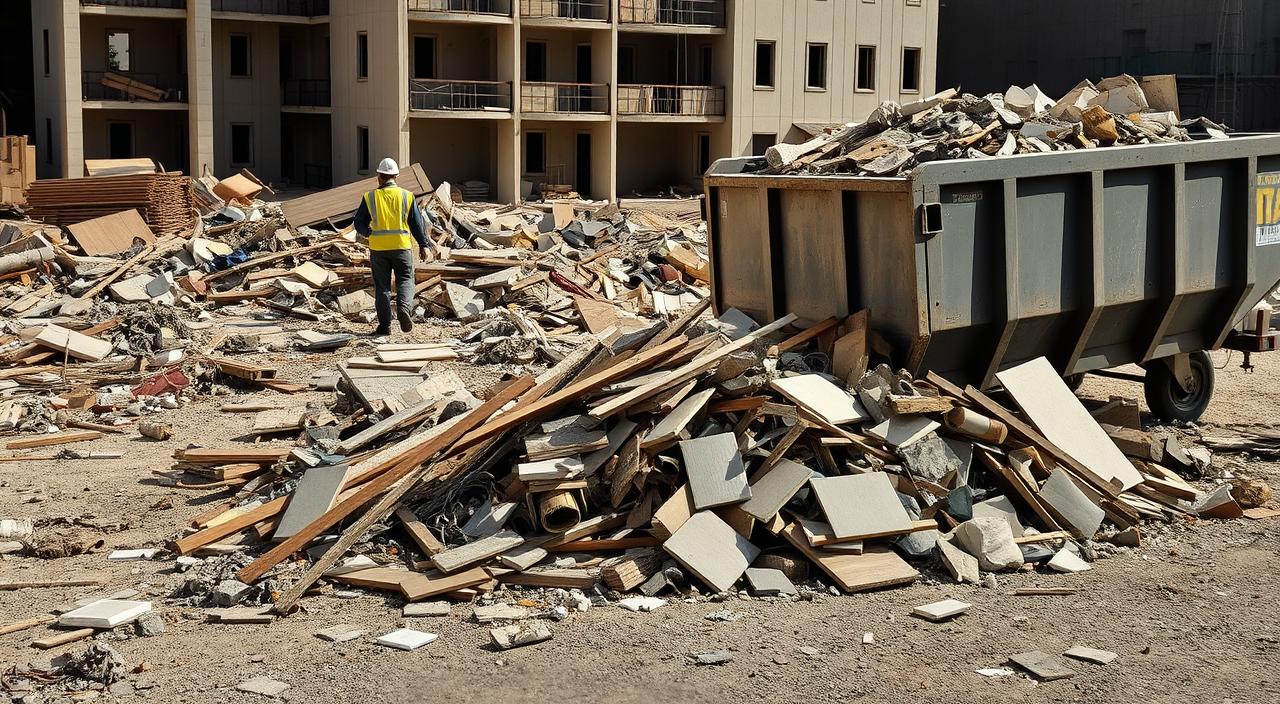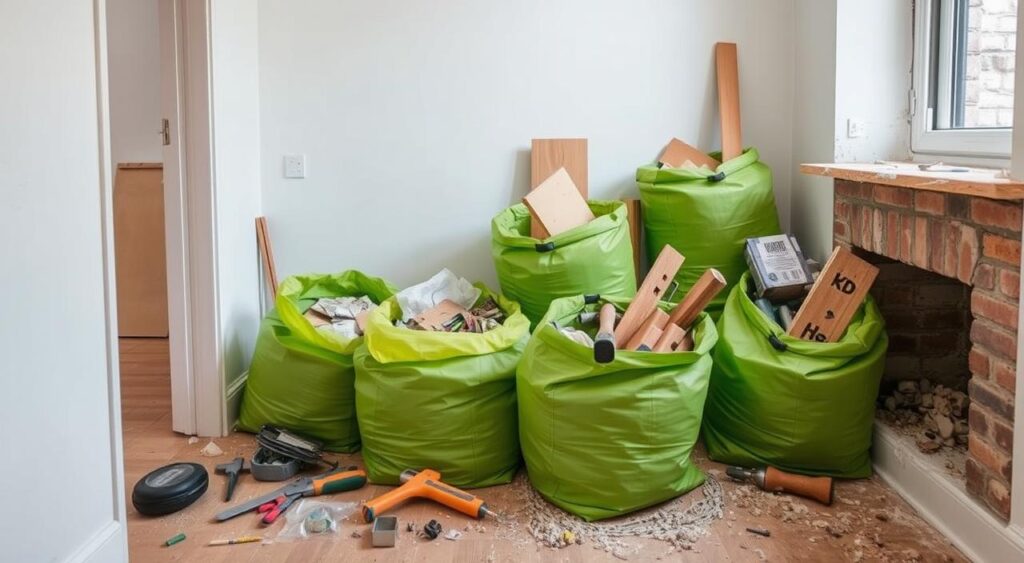Home renovations can breathe new life into a property, but they also generate significant waste. In fact, construction, demolition, and excavation waste disposal make up around 62% of all waste generated in the UK. Disposing of this waste irresponsibly can harm the environment and lead to legal consequences.

If you’re planning a home improvement project, understanding how to manage and dispose of renovation waste is vital for sustainability and compliance. This guide covers the types of waste produced during renovations, legal responsibilities, disposal options, and best practices for recycling and reuse.
Key Takeaways
- Understand the legal “duty of care” for waste disposal in the UK.
- Plan your waste management before starting your renovation.
- Choose between skip hire, collection services, and recycling options.
- Sort and recycle materials wherever possible to minimise landfill use.
- Save time, money, and environmental harm through responsible strategies.
What Is Renovation Waste?
Renovation waste refers to materials discarded during home improvement projects. These include both structural and non-structural elements that are removed or replaced during the process.
Common Types of Renovation Waste
| Material | Disposal Potential |
|---|---|
| Bricks and Concrete | Reuse or specialist disposal |
| Wood | Reuse or recycle |
| Tiles and Ceramics | Specialist recycling |
| Metal (pipes, frames) | Recyclable |
| Plasterboard | Specialist handling |
| Glass | Recyclable (clean only) |
| Old Fixtures (sinks, cabinets) | Reuse or disposal |
| Packaging from New Items | Recycle if clean |
Domestic renovations alone can generate over 27kg of waste per square foot, underlining the need for a structured waste management plan.
The Environmental Impact of Poor Waste Disposal

Disposing of renovation debris incorrectly has far-reaching consequences. Illegally dumped waste can pollute local ecosystems, threaten wildlife, and cause long-term soil and water contamination.
According to DEFRA, in the 2021/22 reporting year, there were over 59,000 incidents of illegal construction and demolition waste dumping. The long-term costs of cleanup, fines, and environmental harm far outweigh the upfront investment in responsible disposal.
Planning Your Renovation Waste Strategy
Before demolition begins, you should have a waste strategy in place. Planning reduces your project’s carbon footprint and ensures compliance with UK regulations.
Step 1: Estimate Your Waste Output
Calculate the expected volume and types of waste. Larger projects may require multiple waste streams or specialist services.
Step 2: Know Your Legal Responsibilities
In the UK, homeowners have a “duty of care” under the Environmental Protection Act 1990. If you’re managing waste yourself, you must use licensed facilities. If hiring professionals, ensure they are registered waste carriers with the Environment Agency.
Check a waste carrier license here (Gov.UK)
Step 3: Develop a Waste Management Plan
Include the following in your plan:
- Waste reduction strategies
- On-site segregation (wood, rubble, metal)
- Arrangements for skip hire or bag collection
- Access to local recycling centres
Disposal Methods for Renovation Waste

You have multiple options for managing renovation waste, depending on your project size, budget, and space.
1. Hiring a Skip
Skips are ideal for larger renovations. They come in various sizes (2-yard mini to 12-yard builders skips) and can be delivered to your site. If placed on a public road, a skip permit is required from your local council.
Find skip permit info from your local council
2. Using Skip Bags
Skip bags are better suited for smaller renovations or when space is limited. They’re delivered flat and collected once full. Some waste carriers offer next-day pickup.
3. Licensed Waste Collection Services
Registered waste carriers can pick up and dispose of renovation waste. Services often include:
- Grab lorry hire for heavy rubble
- Manual loading for indoor materials
- Recycling of metal, wood, and plasterboard
Make sure to ask for a waste transfer note – a legal record of how your waste was handled.
Recycling and Reusing Materials
Reducing landfill use is one of the best ways to make your renovation more eco-friendly.
Separating Recyclables On-Site
Sorting materials before disposal makes recycling easier and cheaper. Key recyclables include:
- Metal (copper, steel, aluminium)
- Wood (untreated)
- Rubble (bricks, tiles, concrete)
- Glass (clean window panes)
Reusing Materials
Many materials can be salvaged and reused in future DIY or construction projects:
- Bricks: for garden paths or walls
- Tiles: for decorative features
- Cabinets and Doors: for upcycling or resale
Some charities and second-hand markets accept reusable building materials.
Donate usable building materials – Community Wood Recycling
Local Recycling Facilities
Local authority recycling centres often accept renovation waste like:
- Rubble and hardcore
- Shed clearance
- Scrap metal
- Wood and plasterboard
Availability varies by location, so check your local council’s waste disposal services:
Find your local council’s recycling centre
Example Waste Management Table
| Waste Type | Disposal Method | Recyclable |
|---|---|---|
| Rubble & Bricks | Grab lorry or recycling yard | Yes |
| Metal Pipes | Scrap yard or collection | Yes |
| Painted Wood | Landfill or specialist | No |
| Unused Fixtures | Donation or resale | Yes |
| Mixed Debris | Skip with sorting | Partially |
Conclusion: Best Practices for Renovation Waste Disposal
Managing renovation waste responsibly benefits the environment, your wallet, and your reputation. To summarise:
- Plan ahead to estimate your waste output and disposal needs.
- Use licensed professionals or registered waste facilities.
- Separate recyclable materials from general waste.
- Reuse and donate wherever possible.
- Stay compliant with UK waste laws and document all transfers.
By following these steps, you contribute to a cleaner, safer, and more sustainable renovation industry. Every homeowner plays a role in reducing landfill waste and protecting natural ecosystems.





